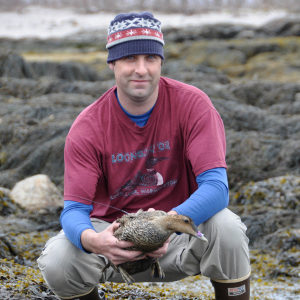In particular, Maine’s coastal islands are critical breeding areas for a significant proportion of the Common Eider population. In May 2016, a pilot field study was initiated in Casco Bay, Maine to evaluate field methodologies designed to document eider duckling survival. Our long-term goal is to use our field findings to guide management actions to conserve the Common Eider.
BRI Lead Investigator: Lucas Savoy
Project Components

Our goal was to uniquely mark a proportion of female Common Eiders at a nesting colony in Casco Bay, in order to track each individual hen’s broods of young until age of fledging to assess duckling survival rates. To uniquely mark hens, we captured Common Eider females prior to their nesting period, and attached colored plastic nasal discs to their bills, as well as a VHF radio transmitter. These methodologies were well described and successfully utilized for Common Eiders and other sea ducks. The nasal discs, which are temporary, are designed to remain on the hens throughout the brood rearing summer months and fall off prior to the post-breeding period in the fall. We conducted preliminary nasal disc attachment technique experiments with captive common eiders, in collaboration with the Livingston Ripley Waterfowl Conservancy.
Throughout the nesting and brood rearing periods (May-July), we will conduct multiple boat-based surveys each week, to document each hen’s location and breeding status, and track the fate of each brood. If marked hens move outside of the boat survey area, we will attempt to locate them with an airplane, equipped with radio telemetry.
Project Updates

In early May, our field team visited a Common Eider nesting colony in Casco Bay, Maine. The timing of our visit was designed to safely capture hen eiders prior to the onset of egg-laying and nesting activities. We utilized a floating mist net technique to capture hen eiders paired with mates near their nesting island. Healthy hen eiders were weighed, measured, banded, and uniquely marked with plastic nasal discs and an external radio transmitter. In total, 50 Common Eider hens were marked for surveillance.We have begun weekly boat-based surveys, radio telemetry tracking, and nasal disc re-observations in order to locate each individual hen and determine the presence or absence of ducklings.
Project Team

This field study is comprised of numerous project investigators from multiple wildlife agencies and organizations.
Chris Dwyer, U.S. Fish and Wildlife Service Region 5, Hadley, Massachusetts
Lucas Savoy, Biodiversity Research Institute, Portland, Maine
Brad Allen, Maine Department of Inland Fisheries and Wildlife, Bangor, Maine
Dan McAuley, USGS Patuxent Wildlife Research Center, Orono, Maine.
Thank you to the many individuals involved with field efforts.
Michelle Kneeland, Bill Hanson, Tim Welch, Alex Dalton, Carrie Gray, Rick Gray, Robby Lambert, Lauren Gilpatrick (BRI); Kelsey Sullivan (MDIFW); Bob Houston (USFWS). Thank you to Nick Tiberio and the Livingston Ripley Waterfowl Conservancy for facilitating preliminary eider tagging techniques.
Project Funders
Photo Credits: Releasing a female Common Eider © Chris Dwyer; A female Common Eider equipped with a satellite transmitter © Chris Dwyer; Attaching a satellite transmitter to a female Common Eider © Chris Dwyer


